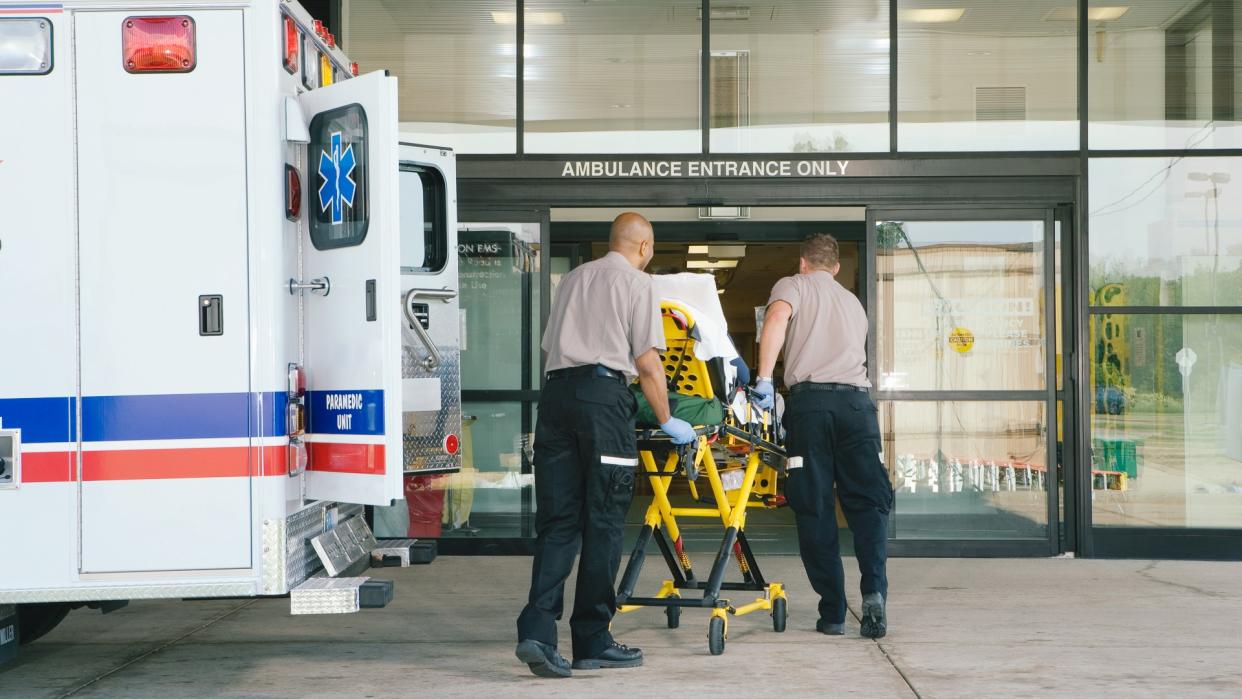7 Major Emergencies That Could Bankrupt You

What would happen if emergency surgery left you with thousands of dollars in medical bills? How would you cover the costs if you got injured in a car accident and were unable to work for weeks? Could you get by financially if your spouse died?
A survey by the Federal Reserve found that 46% of adults couldn’t pay a $400 emergency expense — or would have to borrow or sell something to do so. That’s not surprising, considering that a GOBankingRates survey found that 69% of Americans have less than $1,000 in a savings account. One-third have nothing in savings — no financial cushion for emergencies.
Yet, emergencies can happen at any time. Some can even bankrupt you. Read on to learn about are seven situations that can create financial hardship, and find out how you can prepare for these financial emergencies.
Last updated: May 6, 2021

Medical Emergencies
Health issues are probably the top cause of financial distress for families, said Nancy Doyle, author of “Manage Your Financial Life.” The National Health Interview Survey in 2018 found that about one in seven adults said they or a family member had problems paying medical bills.
To avoid ending up in this situation, be proactive. “The No. 1 thing you can do is get your annual checkup,” Doyle said. “If you ignore your health, you’re more likely to face a health issue.”
Prepare Now: 23 Tips To Build Your Emergency Fund

Proactive Step: Use FSAs and HSAs
You might want to open a flexible spending account or health savings account to make sure cash is available to cover medical costs. Your employer might offer a FSA if you have workplace health coverage. In 2021, you can contribute up to $2,750 to a FSA and use the money to pay for out-of-pocket healthcare costs. However, you usually have to use all the money you set aside within the plan year, or you will lose it.
If you don’t contribute to a FSA, you might consider moving money into a health savings account. To be eligible, you need to have a high-deductible health plan. You can contribute up to $3,550 in 2021 to a HSA if you have individual health coverage with a deductible of at least $1,400. You can contribute up to $6,900 if you have family coverage with a deductible of at least $2,800.
As with a FSA, contributions to a HSA can be deducted from your paycheck before taxes and withdrawn tax-free for healthcare costs. However, you won’t lose funds in your HSA account if you don’t use them within a year.
“It’s forced savings to help alleviate some of the big bills you get,” Doyle said. “Plus, it has a tax advantage because you’re putting money aside pretax.”
See: Here’s How Much Cash You Need Stashed If an Emergency Happens

Job Loss
The Federal Reserve survey found that a job loss was one of the most common financial hardships. The average length of unemployment for those who were out of work as of September 2020 was 20.7 weeks — more than six months, according to the Bureau of Labor Statistics.
However, many Americans wouldn’t be able to cover expenses for that long if they lost their main source of income. The Federal Reserve study found that just under one-third of adults said they couldn’t cover expenses for three months in the event of a “financial disruption.”
Check Out: 8 Savings Tips From People Who Saved Millions

Proactive Step: Build an Emergency Fund
The potential for job loss is why you need an emergency fund with at least six months of net income set aside, said Bruce McClary, vice president of public relations and communications at the National Foundation for Credit Counseling. “The benefit is you don’t have to turn toward your lines of credit to run up costly debt,” he said.
Don’t let setting aside that much money intimidate you. “It is a goal,” McClary said. “It is not a requirement.” Take a close look at your spending to see which discretionary expenses you can cut, and put that money into savings.
Have a set amount of cash automatically transferred from your checking account or paycheck to a savings account each month. “Hopefully, you’ll find enough room to set aside 10% to 20% of income in savings,” McClary said. Put money into an emergency fund regularly and you might save yourself from financial ruin someday.

Disability
More than one in four working 20-year-olds will suffer a disability before retirement age, according to the Social Security Administration.
“With a young family, the risk of disability is real,” Doyle said. If you’re not prepared, your finances could take a big hit if a disability leaves you or your partner unable to work for a while — or permanently.

Proactive Step: Tap Your Social Security Disability Benefits
Social Security provides disability benefits, but you have to meet the qualifications. And the average monthly payment for disabled workers is just $1,259, according to the SSA. You’ll likely need disability insurance to replace more of your income.
Many workers have access to a group policy offered through their employer. However, you might need to buy additional coverage on your own if the workplace policy doesn’t replace enough of your income. A policy that will replace all of your take-home pay might be too expensive, Doyle said.
“Figure out what will be sufficient to get through a challenging time,” she said.

Death of a Spouse
Without proper planning, you can be left scrambling to make ends meet if your spouse or partner dies. More than half of U.S. households would feel the impact of the loss of a primary wage earner within six months, and more than one-third would feel it in a month or less, according to a study by insurance researcher LIMRA and Life Happens, a nonprofit that promotes the benefits of life insurance.
Even the loss of a nonworking spouse can hurt a family’s finances. “If something happens to the partner who stays home, the full-time breadwinner would need support at home,” Doyle said. “The children are not going to take care of themselves.”
Find Out: What Is the Death Tax?

Proactive Step: Take Out Life Insurance
Life insurance can protect your family financially, according to Doyle. For most people, an affordable term-life policy is the best option, she said. A term-life policy will pay your beneficiaries a certain amount if you die within a certain number of years after signing up for coverage. A healthy, nonsmoking 30-year-old can get a 20-year, $250,000 term life policy for just $160 a year — or about $13 a month, according to the study.

Home Repairs
If your furnace goes out or the roof needs to be fixed, the expense of repair can deal your finances a blow. “If you’re hit with a lot of big expenses at once, it can really throw your budget off,” Doyle said.
However, preparation can soften the blow. For starters, spend some money to keep your home well-maintained and head off expensive emergency repairs and replacements. “You will reduce the risk of financial disaster,” she said.
Then, estimate when things around your home might need repair or replacement based on their age and how much it might cost to replace them. Set aside money in savings to cover the costs, which you can spread out if you create a timeline for replacing things.

Proactive Step: Get Homeowners Insurance
In addition to saving for general repairs, also make sure you have enough insurance coverage to protect you if disaster — such as a storm or fire — strikes. Ask your provider if you have guaranteed replacement coverage, which will pay the full cost to rebuild your home the way it was before the disaster, according to the Insurance Information Institute.
Be aware that standard homeowner’s policies don’t cover earthquakes and floods, according to III. You have to buy additional earthquake coverage. And you can buy flood insurance through the National Flood Insurance Program.
New Homeowners: Here’s What You Need To Know for Your Taxes

Car Repairs
A car repair might not seem like a major financial emergency. But if the fix exceeds $1,000, it can be tough for some people to pay the bill, McClary said. “It can snowball and have a devastating effect on your finances,” he said.
Skimping on car repairs to save money can backfire and end up costing you more. So keep your car running smoothly by sticking to the manufacturer’s schedule for oil changes, tire rotation and other maintenance.

Proactive Step: Keep a Separate Emergency Fund
Set money aside in your emergency fund to cover the cost of major repairs. Make sure you also have enough saved to cover the deductible on your auto insurance if you get in an accident. If you have to rely on credit to cover these costs and can’t pay off your balance quickly, the amount of interest you pay can double the total amount of your costs, McClary said.

Lawsuits
You don’t have to be rich or famous to be the target of a lawsuit. And if you are sued because your dog bites someone, you can find yourself in a financial hole.

Proactive Step: Get Liability Insurance
Your homeowner’s insurance policy likely provides some liability coverage. Most such policies provide a minimum of $100,000 in coverage, according to III. You also have liability coverage through your auto insurance. You can pay to increase liability limits for both types of insurance if you need more protection.
Another option for additional protection is to buy an umbrella liability policy. This makes sense if you have assets worth more than the liability limits on your homeowners and auto insurance policies.
You can get a $1 million umbrella policy for about $150 to $300 per year, according to III. It kicks in after you reach the limit on your existing liability coverage and covers the cost of injuries to others, damage to others’ property and even lawsuits against you for things such as libel and slander, according to the insurance company Geico.
More From GOBankingRates
Money’s Most Influential: Where Do Americans Get Their Financial Advice?
‘Rich Dad Poor Dad’ Author Robert Kiyosaki: You Should Never Say ‘I Can’t Afford That’
Here’s How Much You Should Have in Your 401(k) Account, Based on Your Age
John Csiszar contributed to the reporting for this article.
This article originally appeared on GOBankingRates.com: 7 Major Emergencies That Could Bankrupt You
